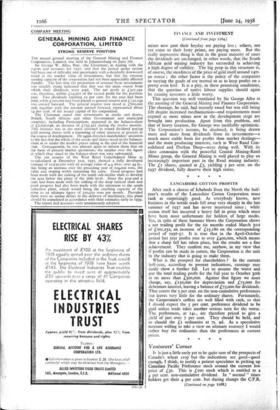LANCASHIRE COTTON PROFITS
After such a chorus of Ichabods from the North the half- year's results of the Lancashire Cotton Corporation must rank as surprisingly good. As everybody knows, new business in the textile trade fell away very sharply in the late summer of 1937 and has never recovered since ' • while cotton itself has incurred a heavy fall in price which must have been most unfortunate for holders of large stocks. Yet, in spite of these hammer blows the Corporation shows a net trading profit for the six months ended March 31st of £201,232, an increase of £25,180 on the corresponding period of 1936-37. It is true that in the April-October period last year profits rose to over £400,000, which means that a sharp fall has taken place, but the results are a fine achievement. They confirm me, anyhow, in my view that if profits can be made in cotton, the Corporation is the unit in the industry that is going to make them.
What is the prospect for shareholders ? In the current half-year, according to present indications, earnings may easily show a further fall. Let us assume the worst and put the total trading profit for the full year to October 3oth at no more than £300,000. Against that figure we must charge, say, £150,000 for depreciation and £75,000 for debenture interest, leaving a balance of £75,000 for dividends. That covers the 5 per cent. on the non-cumulative preferences but leaves very little for the ordinary shares. Fortunately, the Corporation's coffers are well filled with cash, so that I should expect the 5 per cent. preference dividend to be paid unless trade takes another serious turn for the worse. The preferences, at 14s., are therefore priced to give a yield of just over 7 per cent. They should be held, and so should the £r ordinaries at 7s. 9d. As a speculative investor willing to take a view on ultimate recovery I would rather buy the ordinaries than the preferences at current prices.














































 Previous page
Previous page